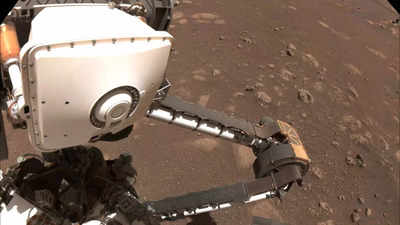- News
- Technology News
- Tech News
- How and why NASA is using AI, machine learning on Mars
Trending
How and why NASA is using AI, machine learning on Mars
NASA’s Perseverance rover employs AI in PIXL for autonomous, real-time mineral analysis on Mars, potentially tracing past microbial life. Developed by JPL and led by Abigail Allwood, it marks a leap in planetary exploration. The Curiosity rover, 3,700 km away, also uses AI for efficient laser rock analysis, enhancing research and scientific output.

NASA recently announced that AI is helping scientists to identify minerals within rocks studied by the Perseverance rover.
While “smart” spacecrafts are still a bit far from becoming reality, advances made with NASA’s Perseverance Mars rover essentially offer promising steps in that direction.
NASA said that for nearly three years, the mission has been testing AI to identify minerals within Martian rocks on Earth. However, it is now for the first time that AI has been used by the Perseverance rover on Mars to make autonomous decisions about rock composition, marking a pivotal moment in planetary exploration.
What AI software is being used and how it works
The AI software that is driving this exploration supports PIXL (Planetary Instrument for X-ray Lithochemistry), which is a spectrometer developed by NASA’s Jet Propulsion Laboratory (JPL). The instrument maps the chemical composition of minerals across a rock’s surface, and helps scientists to determine whether it formed in conditions that could have been supportive of microbial life in Mars’ ancient past.
The AI-powered “adaptive sampling” software autonomously positions the instrument close to a rock target and analyses scans of the target to find minerals worth examining more deeply. NASA says this is all done in real time, without the rover talking to mission controllers back on Earth.
“We use PIXL’s AI to home in on key science. Without it, you’d see a hint of something interesting in the data and then need to rescan the rock to study it more. This lets PIXL reach a conclusion without humans examining the data,” said the instrument’s principal investigator, Abigail Allwood of JPL.
The system automatically focuses on interesting minerals, improving with machine learning. Based on the analysis done by Perseverance, scientists then decide when to ‘pack’ the sample for bringing back to Earth.
Perseverance not the only AI-loaded rover on Mars
AI is also playing a crucial role in the working of Curiosity rovers – stationed about 3,700 kilometres from Perseverance. Curiosity utilises AI to independently select and analyse rocks using a laser, determining their chemical composition by studying the vaporised material.
Notably, Perseverance builds upon this by employing a more advanced AI system for autonomous navigation. While both rovers still require human oversight, these AI capabilities significantly enhance their efficiency and scientific return, allowing scientists to accomplish more tasks in a shorter time frame.
End of Article
Latest Mobiles
FOLLOW US ON SOCIAL MEDIA











